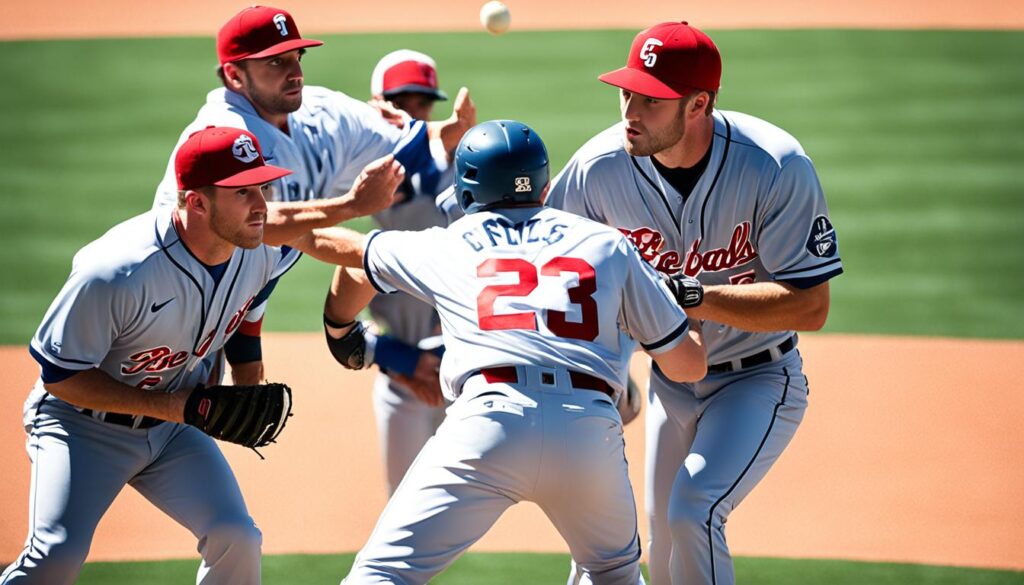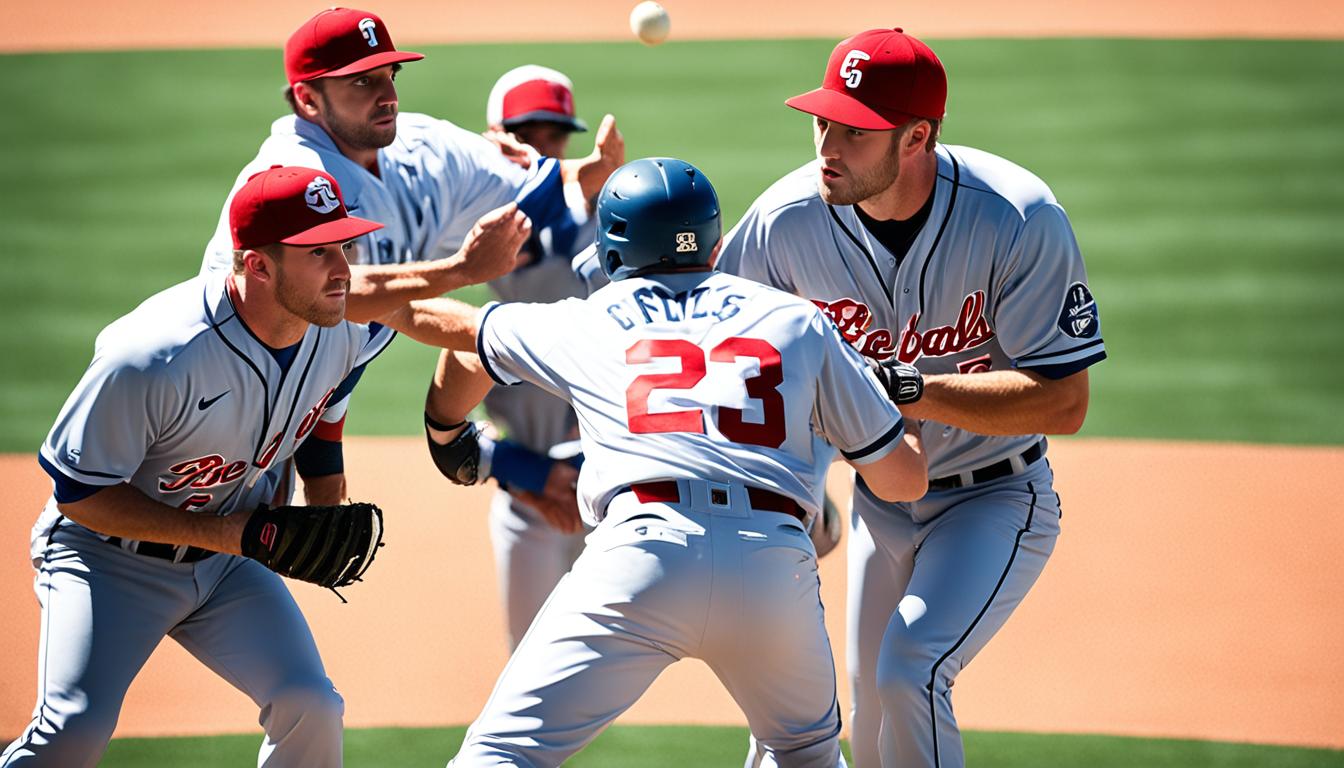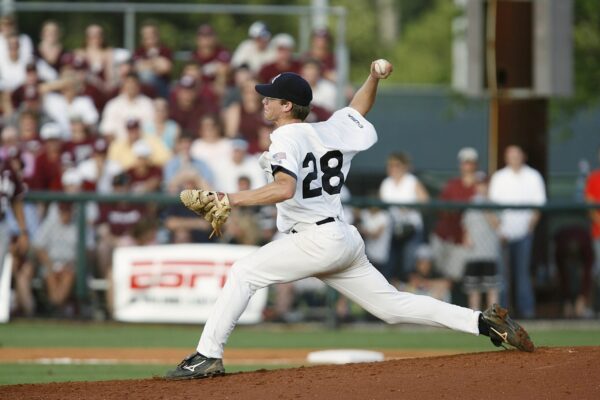
Have you ever wondered what it takes to effectively execute a baseball pickle or rundown play? The art of catching a base runner between two bases requires a combination of base running technique, defensive strategy, and infield play. How can you master this crucial aspect of the game and prevent the runner from advancing? Let’s dive into expert techniques and strategies that will help you ace the baseball pickle or rundown play.
- Understanding the step-by-step process of executing a baseball rundown
- Learning valuable tips from professional baseball players
- Familiarizing yourself with defensive fundamentals during a rundown
- Exploring baserunning strategies when caught in a pickle
- Incorporating pickle drills into your practice routine
Takeaways>
How to Execute a Rundown
Executing a successful baseball rundown is all about efficiency and precision. By utilizing the right techniques, you can minimize the number of throws and increase the chances of tagging out the baserunner. Follow these step-by-step guidelines to master the art of executing a baseball rundown:
- Anticipate the rundown: Position yourself between the two bases where the baserunner is trapped.
- Run hard at the baserunner: By sprinting towards them, you force them to commit to a specific base and make split-second decisions.
- Communicate with your partner: Coordinate with your teammate who is also involved in the rundown. Ensure they are ready to receive the ball and make the tag.
- Make the throw: Once the baserunner commits, quickly make a strong and accurate throw to your partner. Aim for their chest or glove to maximize the chances of a successful tag.
- Force the runner back: If you have a choice, try to make the baserunner retreat towards the smaller base. This narrows their path and gives your team a better opportunity for a tag-out.
- Stay focused: Maintain your concentration throughout the rundown. Keep your eyes on the baserunner and be ready to adjust your position or make additional throws if necessary.
Incorporate these techniques into your practice drills to perfect your execution of a baseball rundown. Remember, the key is to use the fewest number of throws possible while keeping the baserunner on their toes.
Tips from the Pros
When it comes to successfully executing a baseball pickle play, professional players have some valuable tips to offer. By incorporating these tips into your practice drills, you can enhance your defensive skills and effectively execute rundowns during games.
- Run Hard at the Baserunner: One important tip from the pros is to run hard at the baserunner during a pickle play. By putting pressure on the runner and forcing them to make quick decisions, you increase the chances of successfully tagging them out.
- Communicate with Your Teammates: Communication is key in a pickle play. Make sure to communicate with your teammates to ensure everyone is on the same page. Clear communication helps prevent confusion and minimizes the risk of missed opportunities to tag out the runner.
- Secure the Ball for the Tag: It’s crucial to secure the ball properly when executing a pickle play. Maintain a firm grip on the ball and position yourself to make a quick, accurate throw when needed. This ensures that you are ready to tag out the runner efficiently.
Remember, these tips from the pros can significantly improve your performance in pickle plays. Practice these techniques regularly and watch your defensive skills soar!
Professional players provide valuable tips for executing a baseball pickle play.
Defensive Fundamentals During a Rundown
When caught in a rundown, players must adhere to several defensive fundamentals to effectively execute the play. These principles are essential in preventing the runner from advancing and forcing them back towards the starting base. In addition to this, minimizing the number of throws during the rundown reduces the chances of errors and increases the likelihood of a successful outcome. Communication and positioning among infielders play a crucial role in coordinating defensive efforts and executing the rundown flawlessly.
When it comes to defensive strategy during a rundown, the primary objective is to never let the runner advance. Players should focus on redirecting the action back towards the base where the rundown began. This prevents the runner from gaining any additional ground and increases the chances of making the tag or force-out at the starting base.
Infield play is crucial during a rundown as it involves quick reactions and agile movements. Infielders must anticipate the runner’s actions and position themselves strategically to cut off potential escape routes. By angling their bodies towards the base and staying low, infielders can maintain control and create effective defensive barriers.
Effective communication is key during a rundown. Infielders should use clear and concise verbal and non-verbal cues to convey their intentions and coordinate their movements. This ensures that everyone is on the same page and helps prevent miscommunication errors that can allow the runner to escape.
“In a rundown situation, it’s critical for infielders to work together and act decisively. Clear communication and synchronized movements are essential in executing a successful rundown play.” – {insert real player name}
Defensive Fundamentals during a Rundown:
- Never let the runner advance
- Force the action back towards the starting base
- Minimize the number of throws during the rundown
- Communicate effectively with teammates
- Position infielders strategically
Practicing these defensive fundamentals and incorporating them into rundown drills will enhance players’ abilities in executing successful rundowns, further reinforcing their understanding of baseball fundamentals and defensive strategies.
Rundown Defensive Positioning:
| Position | Responsibility |
|---|---|
| Fielder with the ball | Pursue the runner and force them back towards the starting base |
| Trailing fielder | Position behind the runner, ready to receive the throw and make the tag |
| Remaining infielders | Cover bases and potential escape routes to cut off the runner’s options |
Note: The specific defensive positioning may vary depending on the base where the pickoff occurs.
Understanding and implementing the defensive fundamentals described above will significantly contribute to a team’s defensive prowess in rundowns. By reinforcing proper infield play, communication, and defensive strategy, players can effectively prevent runners from escaping the pickle and secure crucial outs.
Baserunning During a Rundown
When baserunners find themselves caught in a pickle during a rundown play, it’s essential to employ specific strategies tailored to the situation at hand. By understanding various tactics and being aware of the presence of other runners on the bases, baserunners can increase their chances of safely returning to a base or potentially advancing. Let’s explore some effective baserunning techniques during rundowns:
Creating Distractions
One effective strategy for a baserunner caught in a pickle between third base and home is to create a distraction. In this situation, another runner on first base can attempt to draw attention or steal second base. By doing so, the defensive players are forced to redirect their focus, giving the trapped baserunner an opportunity to escape the rundown.
Decision-Making Based on Runner Configurations
The baserunner’s decision-making should depend on the positioning of other runners on the bases. If there are no other runners or if all other runners are already in scoring position, the primary objective should be to extend the rundown as long as possible before making a decisive move. This diversionary tactic allows teammates to advance or score, exploiting the defensive team’s attention on the trapped runner.
“In a pickle situation, creating distractions and making calculated decisions based on the presence of other baserunners can significantly impact the outcome of the play.” – Joe Ramirez, former MLB player
Coaches play a vital role in teaching players the importance of heads-up baserunning to avoid getting caught in a pickle. By practicing situational awareness and understanding the possibilities, baserunners can make smart decisions to either escape the rundown or create opportunities for their teammates.
Now, let’s take a look at a visual representation of baserunning strategies during rundowns:
| Situation | Strategy |
|---|---|
| Runner caught between third base and home | Teammate on first base tries to steal second to draw attention away from the trapped runner. |
| Multiple runners on base | Trapped runner extends the rundown while other runners advance to scoring positions. |
| No other runners on base or all runners in scoring position | Trapped runner prolongs the rundown to create distractions and opportunities for teammates to score. |
Baseball Pickle Drills
Incorporating pickle drills into team practices can enhance players’ defensive skills and communication during rundowns. These drills are designed to simulate realistic rundown situations and help players develop effective strategies to execute the baseball pickle play. One valuable resource for pickle drill demonstrations is Cal Ripken Jr.’s video tutorial, which offers valuable insights and techniques for mastering this defensive play.
When practicing pickle drills, it is essential to emphasize the fundamental aspects of a rundown rather than getting caught up in extraneous details, such as the number of outs or other runners on base. By focusing on the core principles of the pickle play, players can hone their defensive instincts and become more proficient in executing rundowns during games.
Here is an example of a simple and effective pickle drill:
- Set up four bases in a diamond shape.
- Assign one player as the runner and another as the fielder.
- The runner starts at one base while the fielder positions themselves in the middle of the diamond.
- The drill begins as the runner attempts to steal the next base.
- The fielder must quickly react, chase the runner, and attempt to tag them out.
- If the runner manages to retreat to their original base, the fielder must continue pursuing until the tag is made.
By repeating this drill, players can enhance their reaction time, agility, and decision-making skills during rundown situations. Furthermore, incorporating effective communication among teammates is crucial to ensure a seamless and successful execution of the baseball pickle play.
Cal Ripken Jr.’s Rundown Situation Drill
“Pickle drills are a key component of developing solid defensive skills in baseball. It’s important for players to understand the nuances of the rundown play and practice executing it in realistic scenarios. By incorporating pickle drills into your training regimen, you can improve your defensive instincts, communication, and overall performance on the field.” – Cal Ripken Jr.
| Pickle Drill Benefits | Key Takeaways |
|---|---|
| Improves defensive skills | Focus on fundamental aspects of rundowns |
| Enhances communication among teammates | Emphasize core principles instead of extraneous details |
| Develops quick reaction time and agility | Practice realistic rundown situations |
Teaching Rundown Defense
Teaching rundown defense is a crucial aspect of mastering the baseball pickle or rundown play. By effectively implementing techniques and strategies, players and coaches can ensure a solid defensive performance on the field. Understanding the core principles of a successful rundown, such as making few throws, returning to the starting base, and circling back to avoid contact with the baserunner, is vital.
It is recommended to incorporate instructional videos that demonstrate different situations and explain the roles of front and back players in rundowns. This visual aid allows players to better understand their responsibilities and the team dynamics involved in executing a flawless rundown. By emphasizing proper technique and communication, players can confidently handle rundowns during games.

Front and Back Player Responsibilities in a Rundown
| Front Player | Back Player |
|---|---|
| Chase the baserunner | Receive the throw |
| Force the baserunner to commit | Apply the tag |
| Make accurate and efficient throws | Communicate with other fielders |
“The key to a successful rundown is the communication and trust between the front and back players. It’s important for both players to understand their roles and work together seamlessly to execute the play.” – Coach Smith
By practicing rundown drills that simulate game scenarios with different infield situations, players can enhance their defensive skills and improve their decision-making abilities. These drills provide a valuable opportunity to fine-tune coordination, timing, and communication among team members, leading to a more cohesive defensive unit.
Teaching rundown defense is an ongoing process that requires regular practice and repetition. By instilling the fundamental principles and providing players with the necessary tools to succeed, coaches can develop a confident and skilled team capable of executing rundowns effectively.
Players Involved in Rundowns
When executing a rundown and picking off a runner, the players involved depend on the base at which the runner is caught. Let’s explore the roles and responsibilities of players when a runner is picked off at first base, second base, or third base.
Final Thoughts on Rundowns
To conclude, rundowns are crucial aspects of baseball that require the proper execution of baseball fundamentals, defensive strategies, and rundown techniques to prevent the runner from advancing and achieve an out. Coaches play a vital role in teaching and reinforcing these key principles to their players.
One important element in executing a successful rundown is minimizing the number of throws involved. By forcing the baserunner to commit and making accurate throws, the defensive team can effectively eliminate the runner’s chances of advancement. It is also essential for the fielders involved in the rundown to circle back after each throw, maintaining proper positioning and preventing the baserunner from escaping.
“The key to a successful rundown is effective communication among players. Clear verbal and non-verbal signals can ensure that everyone is on the same page and knows their role in the play.” – Coach Smith
Practicing rundown drills is essential to enhance defensive capabilities and reinforce these strategies. By simulating real-game situations, players can develop their skills and improve their ability to execute rundowns effectively. These drills should focus on proper footwork, timing, and quick decision-making.
Benefits of mastering baseball rundowns:
- Preventing baserunners from advancing
- Building confidence and trust among teammates
- Showcasing defensive prowess
- Reducing the opponent’s scoring opportunities
By understanding and mastering the intricacies of rundowns, teams can significantly elevate their defensive performance and overall game strategy. Investing time and effort into these defensive techniques is a vital component of a well-rounded baseball team.
Conclusion
Mastering the baseball pickle or rundown play is crucial for both base runners and defenders. By understanding the proper techniques and incorporating effective drills into practices, players can improve their base running technique and defensive strategy, ultimately contributing to the team’s success.
Defensive fundamentals play a key role in executing successful rundowns. By following principles such as making the runner go back towards the starting base and minimizing throws, defenders can effectively prevent the runner from advancing. Communication and positioning among infielders also play a vital role in executing a successful rundown play.
Furthermore, incorporating baseball drills specifically designed for the pickle play can significantly enhance players’ skills and understanding of the game. These drills help athletes master the necessary base running techniques and defensive strategies required during rundowns. By implementing these strategies in games, teams can make a significant impact and turn potential run-scoring opportunities into outs.
Recommended
- FROM THE DIAMOND: THE PSYCHOLOGY BEHIND CATCHERS’ THIRD BASE THROWS
- ELEVATE YOUR GAME WITH EXPERT BASEBALL TIPS

Meet Daniel Anderson, the heart and soul behind Baseball Pro Picks. At 49, Daniel’s life has revolved around baseball, a passion that’s as strong today as it was when he first fell in love with the game. Living in the USA, Daniel has dedicated countless hours to watching, analyzing, and understanding every pitch, hit, and home run, making almost no game missed. His deep-rooted love for the sport is matched only by his commitment to sharing insightful, expert analysis with fellow baseball enthusiasts. With decades of experience and a keen eye for the game’s nuances, Daniel brings a unique perspective that enriches Baseball Pro Picks. Trust Daniel to guide you through the intricacies of baseball with the authority and trustworthiness of a true aficionado.


